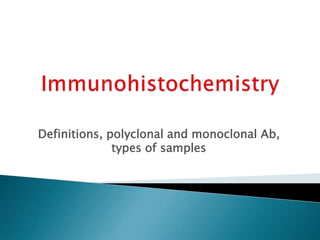
IHC 2
- 1. Definitions, polyclonal and monoclonal Ab, types of samples
- 2. IHC is a method for localizing specific antigens in tissues or cells based on Ag-Ab recognition Immunohistochemistry (IHC) Combines histological, immunological and biochemical techniques for the identification of specific tissue components by means of a specific antigen/antibody reaction tagged with a visible label
- 3. 1945 – Albert Coons 1st used an Ab labeled with a fluorescent dye to visualize tissues 1966 – 1 st developed enzyme labeling instead of fluorescent label 1974 – IHC was performed for the 1st time on routine formalin fixed paraffin embedded sections 1981 – developed avidin-biotin labeling 1991 – Heat induced antigen retrieval technique in IHC was done 1995 – Polymer technology introduced
- 4. is a molecule that stimulate the formation of an antibody and it has one or more antibody binding sites. antigen (Ag), abbreviation of antibody generator These sites are highly specific region being known as antigenic determinant groups or epitopes.
- 5. Antigens have two main properties. • immunogenicity, which is the ability to induce antibody formation. • specific reactivity, which means that the antigen can react “with the antibody it caused to be produced.
- 6. proteins of high molecular weight known as immunoglobulins and are produced after stimulation by an antigen. act specifically against the antigen in an immune response
- 7. Antibodies are divided into five major classes, IgM, IgG, Iga, IgD, and IgE, based on their constant region structure and immune function. The frequently used Ab is IgG molecule it is composed of two pairs of light and heavy polypeptide chains form a Y-shaped structure.
- 8. Abs are also proteins - thus any part of the Ab may itself serve as epitope to induce Ab formation (to which secondary Ab binds) IHC technique prove that Ig molecules can serve both as Ab and Ag
- 9. The amino acid side-chains of the variable domain of an antibody form a cavity which is geometrically and chemically complementary to a single type of antigen epitope. lock (antibody) and key (antigen) The associated antibody and antigen are held together by a combination of hydrogen bonds, electrostatic interactions, and van der Waals’ forces.
- 10. Antibody specificity This refers to the characteristics of an antibody to bind selectively to a single epitope on an antigen. Sensitivity This refers to the relative amount of antigen that an immunohistochemical technique is able to detect. A technique with high sensitivity is able to detect smaller amounts of antigen than a technique with low sensitivity.
- 11. Polyclonal antibodies Polyclonal antibodies are produced by immunizing an animal with a purified specific molecule (immunogen) bearing the antigen of interest. B cells will produce immunoglobulin specific for the antigen The IgG is produced from different clones of plasma cells (polyclonal). Each clone will produce an antibody with a slightly different specificity to the variety of epitopes present on the immunogen. A polyclonal antiserum is therefore a mixture of antibodies to different epitopes on the immunogen.
- 12. are monospecific antibodies that are made by identical immune cells Which produced by hybridoma technique It is a technology of forming hybrid cell lines (called hybridomas) by fusing an antibody- producing B cell with a myeloma (B cell cancer) cell that is selected for its ability to grow in tissue culture and for an absence of antibody chain synthesis. The antibodies produced by the hybridoma are all of a single specificity and are therefore monoclonal antibodies
- 15. Polyclonal antibodies –Mixtures of different antibodies to a single antigen are called polyclonal antibodies. (Large complex antigens may have multiple epitopes and elicit several antibody types) Monoclonalantibodies – Antibodies specific for a single epitope and produced by a single clone are called monoclonal antibodies
- 16. Polyclonal antibody greater potential for false positive staining due to antibodies cross-reacting to undesired targets.(background staining) Monoclonal antibody highly specific less background
- 17. steps -Preparation of sample -Immunohistochemical reaction and Visualizing the reaction -Counter stain.
- 18. Is the type of sample and the fixation affecting the IHC reactions ?
- 19. Adequate and appropriate fixation is the cornerstone of all histological and immunohistochemical preparations. The demonstration of many antigens depends heavily on the fixative employed.
- 20. There is no one fixative that is ideal for all antigens. Most laboratories use fixation based on formalin, such as unbuffered 10% formal saline or 10% neutral buffered formalin. Some groups prefer picric acid fixation (Bouin’s) or mercuric fixation.
- 21. Good fixation is the delicate balance between under-fixation and over-fixation Ideal fixation is the balance between good morphology and good antigenicity. Poor fixation or delay in fixation causes loss of antigenicity or diffusion of antigens into the surrounding tissue.
- 22. Although the use of frozen sections for diagnostic purposes is decreasing, immunohistochemistry on frozen sections remains an important histological tool Although frozen sections have certain disadvantages compared to paraffin sections, including poor morphology, limited retrospective studies, and storage of material, the technique should be considered the gold standard when evaluating and assessing new antibodies.
- 23. Acetone-fixed smears are often preferred by the immunohistochemist, since acetone allows a wide range of primary antibodies to be employed without destroying the target epitopes.